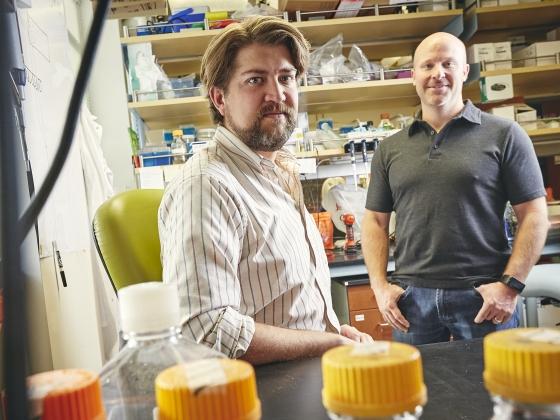
Credit: Adrian Sanchez-Gonzalez
BOZEMAN — Research conducted at Montana State University shows that microbes in the human gut play an important role in protecting against arsenic toxicity, a problem that affects an estimated 200 million people who are exposed to arsenic through contaminated drinking water.
For the past five years, MSU doctoral candidate Michael Coryell has worked with his adviser, Seth Walk, and committee member, Timothy McDermott, to research how the human gut microbiome affects arsenic after it has been ingested. Now, Coryell is the lead author of a paper published Dec. 21 in the journal Nature Communications that details his findings of how the gut microbiome is essential for full protection against acute arsenic toxicity.
With arsenic topping the federal Agency for Toxic Substances and Disease Registry’s list of the most toxic chemicals for the past 20 years, the research is particularly important because even chronic low levels can lead to cancer or cardiovascular disease later in life.
Coryell, a doctoral candidate in microbiology and immunology and fellow in the Molecular Biosciences Program in MSU’s College of Agriculture and the College of Letters and Science, said he is hopeful his work will contribute to the development of probiotic and microbiome-focused therapies that can mitigate the risk for arsenic toxicity.
“One of the next big challenges for microbiome researchers will be translating laboratory findings like this into real-world solutions,” said Coryell, who in 2016 won a prestigious Ruth L. Kirschstein Individual Predoctoral National Research Service Award from the National Institutes of Health.
Past studies have shown that microbes in the environment can biochemically transform naturally occurring arsenic in soil or rocks — either into less toxic or more toxic forms –a topic McDermott researches in MSU’s Department of Land Resources and Environmental Sciences in the College of Agriculture.
What researchers don’t know as much about is what microbes in the human gut do with arsenic before it is absorbed into the body, said Walk, associate professor in MSU’s Department of Microbiology and Immunology and senior author of the paper.
“There are many factors that influence disease — a person’s environment, diet, genetics — but we can only evaluate some of those things in human studies by observing different genotypes of people who have different diets or drink water from different sources,” Walk said.
Coryell used laboratory mice to create experimental controls to sort out the variables’ influences. He found that antibiotics disrupted the gut microbiome, allowing more arsenic to accumulate in the tissues, rather than being excreted.
“That was an interesting finding because it showed that even though there was some microbial activity in the gut, the mice were not as good at getting rid of the arsenic and were probably taking more of it into their system and building up more in their tissues,” Coryell said.
Mice raised without any microorganisms were similarly affected, Coryell said. But when organisms from the human microbiome were introduced, they had a protective effect.
“That was a big advance,” Walk said, “because we were able to look at the germ-free mice and put back the microbiomes we wanted to examine from different people. We found that depending on which microbiome the mice got, they were protected to varying degrees.”
Those results suggest that the microbiome of some people may be more protective than others, Walk said, and may answer the question of why some people who drink from a shared water source tainted with arsenic develop disease later in life while others don’t.
“That idea really hasn’t been incorporated into any epidemiological study or model,” Walk said. “Folks are moving into this field, but what our data shows pretty definitively is that both the microbiome and its composition matter.
“So, in order to predict how likely certain individuals are to develop disease, we need to account for the microbiome and just how protective it is,” he said. “These results help us establish that foundation.”
A better understanding of how the microbiome protects against toxins like arsenic could benefit communities or villages with contaminated water sources through probiotic or other microbiome therapies, especially since it is not always practical or possible to replace a water source, Walk said.
“Microbiome research is moving to microbiome-focused therapies for what we know it plays a role in, and clean food and water is a big topic here in Montana and around the world,” he said.
###
To view the full publication in Nature Communications, go to: https:/
Media Contact
Seth Walk
[email protected]
406-994-2649
Original Source
http://www.
Related Journal Article
http://dx.




